The THHN solar cable market is estimated to be valued at USD 1051.0 million in 2025 and is projected to reach USD 2146.1 million by 2035, registering a compound annual growth rate (CAGR) of 7.4% over the forecast period. The 10-year growth comparison of the THHN solar cable market illustrates a strong upward trend, with market value projected to rise from USD 1,051 million in 2025 to USD 2,146.1 million by 2035, reflecting a compound annual growth rate (CAGR) of 7.4%. Over the first few years, steady increases are expected, with the market value rising from USD 1,051 million in 2025 to USD 1,128.8 million in 2026, reaching USD 1,212.3 million by 2027. This early-stage growth is expected to be driven by increasing installations of solar energy systems and rising demand for durable, high-performance cables capable of withstanding harsh environmental conditions.
As the decade progresses, it is anticipated that the THHN solar cable market will experience more pronounced growth, particularly between 2030 and 2035. This growth is largely attributed to the increasing adoption of solar energy as a key power source, alongside rising infrastructure investments in renewable energy projects globally. By 2035, the market is projected to reach USD 2,146.1 million, signifying a significant leap. The upward trajectory in this market suggests that THHN solar cables will play a crucial role in the expansion of solar energy systems, positioning them as an essential component in sustainable energy infrastructure.
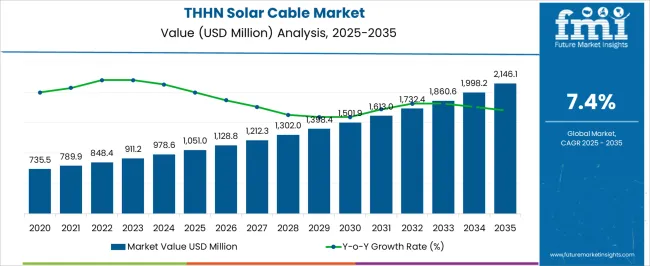
| Metric | Value |
|---|---|
| THHN Solar Cable Market Estimated Value in (2025 E) | USD 1051.0 million |
| THHN Solar Cable Market Forecast Value in (2035 F) | USD 2146.1 million |
| Forecast CAGR (2025 to 2035) | 7.4% |
The THHN solar cable market is witnessing steady expansion, driven by the increasing demand for reliable and efficient electrical connections in solar power generation and distribution systems. The market’s growth is being supported by the global shift toward renewable energy adoption, combined with large-scale investments in photovoltaic infrastructure. THHN cables, known for their thermal resistance, durability, and compliance with safety standards, are becoming the preferred choice for both on-grid and off-grid solar installations.
Advancements in manufacturing processes have enhanced the mechanical strength, insulation properties, and flexibility of these cables, ensuring superior performance under extreme environmental conditions. Regulatory mandates in several regions are encouraging the adoption of high-quality cabling solutions that improve energy transmission efficiency and reduce power losses.
The rising trend of integrating solar energy into industrial, commercial, and residential applications is expanding the market’s customer base As solar projects scale in capacity and complexity, the demand for THHN solar cables is expected to remain strong, with manufacturers focusing on capacity expansion and innovation to cater to evolving industry requirements.
The THHN solar cable market is segmented by end use, current, and geographic regions. By end use, THHN solar cable market is divided into Industrial, Residential, and Commercial. In terms of current, THHN solar cable market is classified into DC and AC. Regionally, the THHN solar cable industry is classified into North America, Latin America, Western Europe, Eastern Europe, Balkan & Baltic Countries, Russia & Belarus, Central Asia, East Asia, South Asia & Pacific, and the Middle East & Africa.
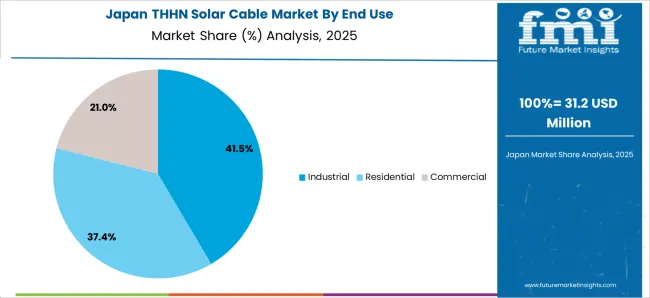
The industrial end use segment is expected to account for 42.1% of the THHN solar cable market revenue share in 2025, making it the leading end user category. This leadership is being driven by the extensive use of solar energy in manufacturing facilities, warehouses, processing plants, and other large-scale industrial operations. Industries are increasingly deploying solar power systems to reduce electricity costs, meet sustainability targets, and ensure energy reliability in regions with unstable grid supply.
The robust design of THHN cables allows them to withstand the demanding conditions of industrial environments, including exposure to heat, chemicals, and mechanical stress, which makes them highly suitable for such applications. The segment’s growth is also supported by government incentives and corporate initiatives promoting renewable energy integration in industrial operations.
Continuous investment in solar capacity by energy-intensive sectors is further reinforcing demand for high-quality cabling solutions. As industries move toward cleaner and more cost-effective energy sources, the adoption of THHN solar cables in this segment is expected to maintain its upward trajectory.

The DC current segment is projected to hold 55.4% of the THHN solar cable market revenue share in 2025, positioning it as the dominant current type category. This dominance is being reinforced by the critical role of DC cabling in connecting photovoltaic modules to inverters, ensuring efficient power transfer in solar systems. The use of THHN cables in DC applications offers superior conductivity, minimal power loss, and long-term reliability under high-voltage conditions.
Their resistance to UV radiation, moisture, and temperature fluctuations makes them ideal for outdoor solar installations where consistent performance is essential. Growing adoption of utility-scale and commercial solar projects is increasing the demand for DC wiring solutions that comply with international safety and efficiency standards.
Furthermore, advancements in cable insulation and jacketing materials are enhancing the durability and operational lifespan of THHN DC cables. As solar installations continue to expand globally, the demand for reliable DC cabling solutions is expected to remain a key driver of growth in this segment.
The THHN solar cable market is experiencing strong growth driven by increased solar energy installations and infrastructure development. Opportunities are emerging in residential, commercial, and large-scale solar projects as governments push for cleaner energy. Trends toward higher durability and performance standards are shaping product development. However, challenges related to raw material costs and supply chain disruptions persist. The market outlook remains positive as the demand for reliable, high-performance cables in solar applications continues to rise globally.
The THHN solar cable market is experiencing robust demand, driven by the rapid growth of solar energy installations worldwide. As governments and industries focus on renewable energy sources, the adoption of solar power systems is accelerating, which in turn boosts the need for high-quality cables for electrical connectivity. THHN cables, known for their durability, high-temperature resistance, and efficient current transfer, are increasingly being used for solar projects. As solar capacity expands globally, the demand for THHN solar cables is expected to continue rising.
There are significant opportunities in the THHN solar cable market due to ongoing solar infrastructure development. Many countries are focusing on large-scale solar power plants, which require high-performance cables for energy transmission and distribution. Additionally, the shift toward residential and commercial solar installations is also increasing demand for robust, weather-resistant cables. The global push for renewable energy, coupled with favorable government policies and incentives, provides ample growth opportunities for cable manufacturers to cater to the expanding solar infrastructure market.
As the solar industry grows, there is a noticeable trend toward higher durability and performance standards for cables. THHN cables, known for their versatility, are being upgraded to meet the increasing requirements of solar energy systems. These upgrades include enhanced insulation to withstand harsh environmental conditions such as UV exposure, moisture, and extreme temperatures. With solar panels being deployed in more diverse climates, the market is seeing a rise in demand for THHN cables that offer superior longevity and higher performance, supporting the industry's need for reliable power transmission.
The THHN solar cable market faces challenges stemming from fluctuating raw material prices, particularly copper and PVC. As these materials make up the core components of the cables, price volatility can significantly impact manufacturing costs and, in turn, the pricing of the final product. Additionally, supply chain disruptions, especially in regions heavily dependent on imported raw materials, can lead to delays in production and delivery. These challenges could limit the market's ability to meet growing demand promptly and may affect overall profitability for manufacturers.
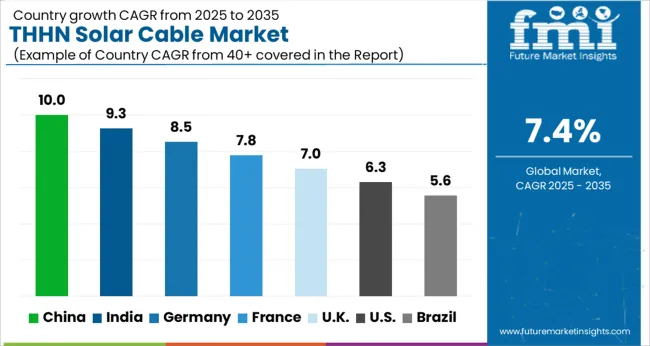
| Country | CAGR |
|---|---|
| China | 10.0% |
| India | 9.3% |
| Germany | 8.5% |
| France | 7.8% |
| UK | 7.0% |
| USA | 6.3% |
| Brazil | 5.6% |
The global THHN solar cable market is projected to grow at a 7.4% CAGR from 2025 to 2035. China leads with a growth rate of 10%, followed by India at 9.3%, and Germany at 8.5%. The United Kingdom records a growth rate of 7%, while the United States shows the slowest growth at 6.3%. The varying growth rates are driven by government incentives, rising demand for renewable energy solutions, and the increasing focus on sustainable infrastructure. Emerging markets like China and India are seeing higher growth due to rapid adoption of solar power, expanding energy infrastructure, and governmental support for renewable energy. In more developed markets like the USA and the UK, steady growth is driven by incentives, established solar systems, and continued advancements in solar technologies. This report includes insights on 40+ countries; the top markets are shown here for reference.
The THHN solar cable market in China is projected to grow at a CAGR of 10%. The increasing adoption of solar energy in China, driven by government incentives and a growing commitment to renewable energy sources, is fueling the demand for high-quality solar cables. China is one of the largest producers and consumers of solar panels globally, and with solar power becoming a major component of the country’s energy strategy, the need for reliable and durable cabling solutions like THHN cables is rising. Additionally, China's push to modernize infrastructure and support sustainable energy solutions has made it a key player in the global solar cable market. As solar installations continue to expand, both in residential and commercial sectors, the demand for THHN solar cables is expected to accelerate in the coming years.
The THHN solar cable market in India is projected to grow at a CAGR of 9.3%. India is aggressively expanding its solar energy capacity to meet its ambitious renewable energy goals, making it one of the fastest-growing markets for solar products. The government’s focus on promoting solar power through schemes like the National Solar Mission and incentives for solar panel installations is increasing the need for reliable and efficient cables. As residential, commercial, and industrial solar installations rise, so does the demand for high-performance cabling systems like THHN solar cables. India's rapidly expanding energy infrastructure, coupled with increasing environmental concerns, is expected to continue driving the growth of the solar cable market.
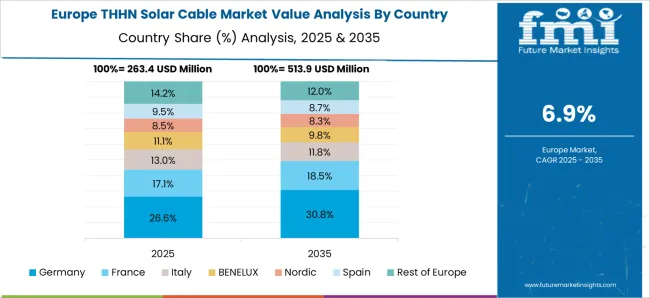
The THHN solar cable market in Germany is projected to grow at a CAGR of 8.5%. Germany, as one of the leaders in renewable energy adoption in Europe, has a strong and growing solar power market, which is significantly driving the demand for high-quality cabling solutions. The country’s focus on reducing its carbon footprint and transitioning to sustainable energy sources is boosting the installation of solar systems across residential, commercial, and industrial sectors. The demand for efficient and reliable solar cables like THHN cables is further being supported by Germany’s commitment to improving its energy infrastructure. The adoption of solar energy as a key component of Germany’s green energy strategy continues to bolster market expansion.
The THHN solar cable market in the United Kingdom is projected to grow at a CAGR of 7%. The UK has seen steady growth in its solar energy sector, with increased investments in renewable energy projects and the government's push for carbon neutrality. The demand for high-quality cables, such as THHN cables, is growing as solar power installations continue to rise across homes, businesses, and public infrastructure. Government initiatives, including feed-in tariffs and renewable energy credits, are expected to further drive the market, creating more opportunities for solar energy systems and, consequently, the need for durable and efficient cables. The UK’s transition to green energy is expected to continue supporting the demand for THHN solar cables.
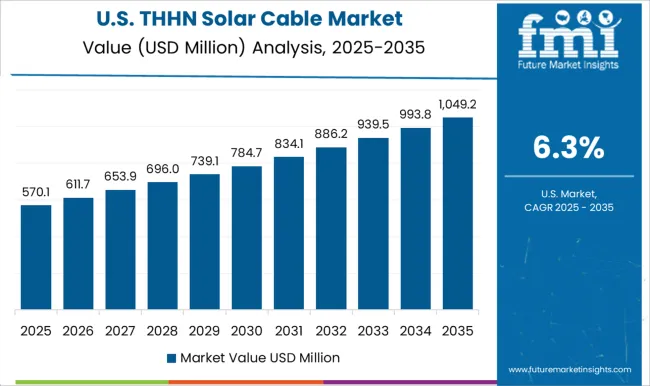
The THHN solar cable market in the United States is projected to grow at a CAGR of 6.3%. The USA continues to see a steady rise in solar installations driven by environmental regulations and incentives such as the federal solar tax credit. As solar energy adoption expands, so does the need for reliable and durable solar cables like THHN, which are crucial for ensuring the efficiency and safety of solar systems. The rise in both residential and utility-scale solar installations in the USA, along with a growing focus on sustainable infrastructure, is contributing to steady growth in the market. However, the growth rate is slower compared to emerging markets, as the USA market is already well-established in solar energy systems.
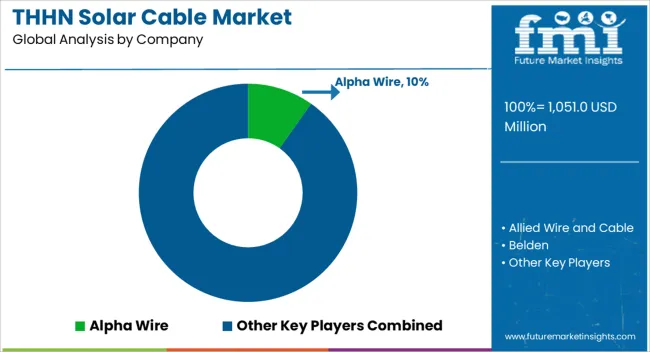
Leading suppliers in the THHN solar cable market, such as Alpha Wire, Allied Wire and Cable, and Belden, are strengthening their market presence by providing high-quality, durable cables designed to withstand the unique challenges of solar power installations. These companies focus on offering cables that deliver high electrical conductivity, superior insulation, and weather-resistant properties, essential for maintaining the long-term reliability and safety of solar systems. By leveraging their global distribution networks and R&D capabilities, these players are addressing the growing demand for efficient and cost-effective wiring solutions in the solar industry. With their advanced manufacturing technologies, they ensure that their products meet international standards and are compatible with a variety of photovoltaic systems, making them key players in the rapidly expanding renewable energy sector.
Other major players like Fujikura, General Cable, and Prysmian Group are tapping into the growing need for high-performance cables that can endure harsh environmental conditions, including extreme temperatures and UV exposure. Their focus on innovation has led to the development of advanced THHN cables with enhanced flexibility and flame-retardant properties, helping to meet the stringent requirements of both residential and commercial solar installations. Companies such as Nexans, Southwire Company, and TE Connectivity are leveraging their expertise in electrical systems to offer integrated solutions that include cables, connectors, and accessories for solar power applications. Regional suppliers like KEI Industries, Polycab, and RR Kabel are catering to local demand by providing cost-effective and reliable cable solutions. As the solar energy market continues to grow, these companies will need to maintain a competitive edge through continuous product innovation, sustainability, and strong relationships with solar equipment manufacturers and installers.
| Item | Value |
|---|---|
| Quantitative Units | USD 1051.0 Million |
| End Use | Industrial, Residential, and Commercial |
| Current | DC and AC |
| Regions Covered | North America, Europe, Asia-Pacific, Latin America, Middle East & Africa |
| Country Covered | United States, Canada, Germany, France, United Kingdom, China, Japan, India, Brazil, South Africa |
| Key Companies Profiled | Alpha Wire, Allied Wire and Cable, Belden, Fujikura, Furukawa Electric, General Cable, Havells, Helukabel, Hellenic Group, Kabelwerk Eupen, KEI Industries, Lapp Group, Leoni, LS Cable and System, Nexans, Northwire, Polycab, Prysmian Group, RR Kabel, Southwire Company, and TE Connectivity |
| Additional Attributes | Dollar sales by cable type (single core, multi-core) and insulation material (PVC, XLPE) are key metrics. Trends include rising demand for durable, UV-resistant cables in residential and commercial solar installations. Regional adoption, advancements in cable manufacturing, and growing solar energy adoption are influencing market growth. |
The global THHN solar cable market is estimated to be valued at USD 1,051.0 million in 2025.
The market size for the THHN solar cable market is projected to reach USD 2,146.1 million by 2035.
The THHN solar cable market is expected to grow at a 7.4% CAGR between 2025 and 2035.
The key product types in THHN solar cable market are industrial, residential and commercial.
In terms of current, dc segment to command 55.4% share in the THHN solar cable market in 2025.
Explore Similar Insights

Thank you!
You will receive an email from our Business Development Manager. Please be sure to check your SPAM/JUNK folder too.
Chat With
MaRIA